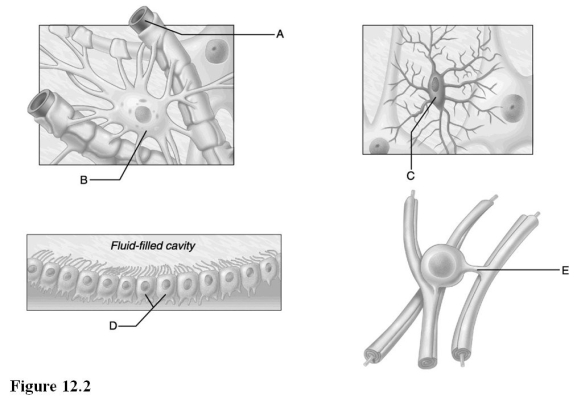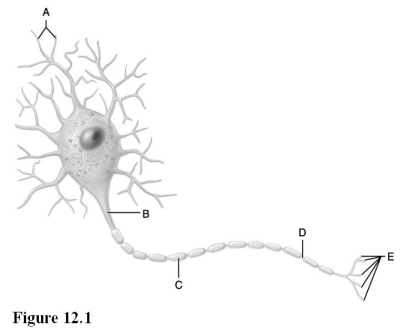A) axon of postsynaptic neuron, dendrite of presynaptic neuron, synaptic cleft
B) dendrite of presynaptic neuron, synaptic cleft, axon of postsynaptic neuron
C) axon of presynaptic neuron, synaptic cleft, dendrite of postsynaptic neuron
D) synaptic cleft, dendrite of postsynaptic neuron, axon of presynaptic neuron
F) B) and C)
Correct Answer

verified
Correct Answer
verified
Multiple Choice
The entire nerve is surrounded by a tough fibrous sheath called the
A) endoneurium.
B) perineurium.
C) ectoneurium.
D) epineurium.
F) C) and D)
Correct Answer

verified
Correct Answer
verified
Multiple Choice
 Use the diagrams above to answer the following questions.
-Identify which diagram represents a microglial cell.
Use the diagrams above to answer the following questions.
-Identify which diagram represents a microglial cell.
A) A
B) B
C) C
D) D
E) E
G) A) and B)
Correct Answer

verified
Correct Answer
verified
Multiple Choice
Of the following, which is the only structure that is in the PNS, as opposed to the CNS?
A) a tract
B) white matter
C) a ganglion
D) gray matter
F) B) and C)
Correct Answer

verified
Correct Answer
verified
Multiple Choice
A man walking barefoot stepped on a piece of glass. His foot jerked upward in which type of reflex?
A) somatic, polysynaptic withdrawal reflex
B) visceral, monosynaptic stretch reflex
C) somatic, monosynaptic withdrawal reflex
D) visceral, polysynaptic withdrawal reflex
F) C) and D)
Correct Answer

verified
Correct Answer
verified
Multiple Choice
In the spinal cord, the cell bodies of most interneurons lie in
A) sensory ganglia.
B) the PNS.
C) the dorsal half of the gray matter.
D) the ventral half of the white matter.
F) A) and C)
Correct Answer

verified
Correct Answer
verified
Multiple Choice
An axon collateral from one neuron that circles back and synapses with a previous neuron describes
A) a converging circuit.
B) parallel processing.
C) a reverberating circuit.
D) serial processing.
F) B) and C)
Correct Answer

verified
Correct Answer
verified
Short Answer
Cytoplasm, organelles, and neurotransmitters move through the cytoplasm of the axon by a mechanism called ________.
Correct Answer

verified
Correct Answer
verified
Multiple Choice
The chemical substance that is released at axon terminals is called a
A) hormone.
B) neurotransmitter.
C) synaptic vesicle.
D) Nissl body.
F) A) and C)
Correct Answer

verified
Correct Answer
verified
Multiple Choice
The ________ of a presynaptic neuron associates with the dendrite of a postsynaptic neuron.
A) synapse
B) axon terminal
C) axon
D) cell body
E) dendrite
G) B) and D)
Correct Answer

verified
Correct Answer
verified
Short Answer
________ processing occurs when information from a single neuron is sent along two or more pathways traveling in the same direction.
Correct Answer

verified
Correct Answer
verified
Multiple Choice
Nonmyelinated axons
A) are thicker than myelinated axons.
B) are not associated with any Schwann cells.
C) conduct impulses more slowly than myelinated axons.
D) occur in the PNS, but not in the CNS.
F) None of the above
Correct Answer

verified
Correct Answer
verified
True/False
In a converging circuit, one presynaptic neuron synapses with many other neurons.
B) False
Correct Answer

verified
Correct Answer
verified
True/False
Special somatic senses have receptors that are located mostly in the head, including hearing and balance and vision.
B) False
Correct Answer

verified
Correct Answer
verified
Multiple Choice
Which of these is not a function of the nervous system?
A) sensory input
B) motor innervation to muscles or glands
C) integration of motor and sensory information
D) secreting hormones into the bloodstream to affect far-away organs
F) All of the above
Correct Answer

verified
Correct Answer
verified
Multiple Choice
 Use the diagram pictured above to answer the following questions.
-Identify the letter that indicates the region of a neuron where neurotransmitters are released.
Use the diagram pictured above to answer the following questions.
-Identify the letter that indicates the region of a neuron where neurotransmitters are released.
A) A
B) B
C) C
D) D
E) E
G) B) and E)
Correct Answer

verified
Correct Answer
verified
Short Answer
These neurons reside only in the CNS and connect motor and sensory neurons.
Correct Answer

verified
interneuro...View Answer
Show Answer
Correct Answer
verified
View Answer
Short Answer
A ________ circuit occurs when many neurons synapse onto one neuron.
Correct Answer

verified
Correct Answer
verified
Multiple Choice
Mitochondria are particularly abundant here.
A) synapse
B) axon terminal
C) axon
D) cell body
E) dendrite
G) C) and E)
Correct Answer

verified
Correct Answer
verified
Multiple Choice
The difference between myelinated and unmyelinated axons in the PNS is that
A) Schwann cells are not associated with unmyelinated axons.
B) Schwann cells form more widely spaced nodes of Ranvier in unmyelinated axons.
C) Schwann cells simultaneously surround multiple axons in myelinated axons.
D) Schwann cells wrap around myelinated axons in concentric layers.
F) A) and D)
Correct Answer

verified
Correct Answer
verified
Showing 61 - 80 of 112
Related Exams